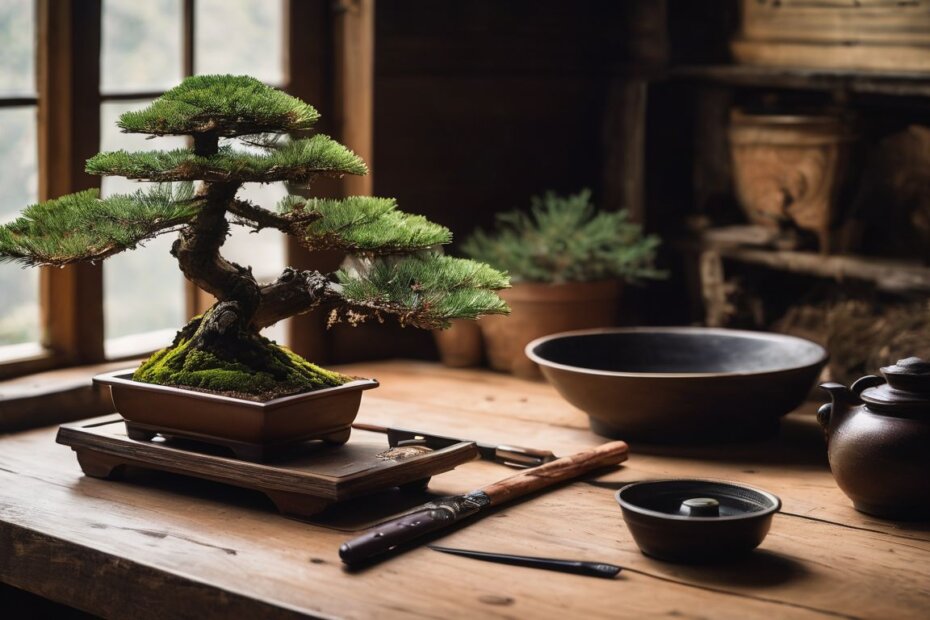Are you mesmerized by the miniature world of bonsai trees and longing to shape a little piece of nature with your own hands? Perhaps you’ve admired the Japanese art of bonsai but assumed it’s too complex for a beginner, especially when it comes to pine trees.
These mighty giants might seem daunting to turn into tiny treasures, but fear not! This guide is crafted specifically for novices eager to learn the art without getting lost in professional lingo.
Interestingly, did you know that cultivating a pine bonsai requires pruning its roots and branches regularly? It’s one way this craft blends gardening skills with creative design. In our easy-to-follow steps below, we’ll show you how to select your tree, master pruning techniques, and provide essential care tips so your pine tree thrives as a delightful bonsai.
Get ready; by the end of this article, you’ll be equipped with knowledge to start your bonsai journey confidently—let’s grow together!
Key Takeaways
- Start with a young, healthy pine tree about 8 years old for the best bonsai results.
- Learn pruning and wiring techniques to shape and maintain your pine bonsai’s size and style.
- Keep your pine bonsai outside in full sun to encourage small needles and proper growth.
- Repot every few years and use balanced fertilizer during the growing season for strong trees.
- Remove old needles regularly to keep your pine bonsai looking neat and tidy.
Steps for Bonsai-ing a Pine Tree
Choosing the right pine tree is crucial for bonsai-ing. Proper propagation and pruning techniques are essential to shaping the pine tree into a bonsai. Caring for a pine bonsai involves attention to watering, sunlight, soil, and regular pruning maintenance.
Choosing the right pine tree
Look for a young pine tree about 8 years old if you want to create a Shohin sized bonsai. Picking the right pre-bonsai or nursery stock is key. You need a healthy tree with good potential for training and shaping.
Check for strong roots, an interesting trunk, and branches that can be styled.
Consider different pine bonsai species before making your choice. Some species might suit your climate better than others. Be sure the one you pick can thrive where you plan to place it, which should be outside in full sun according to care recommendations.
This will help keep your pine bonsai’s needles small and ensure it grows well.
Propagation and Pruning Techniques
After choosing the right pine tree, it’s crucial to understand the propagation and pruning techniques to ensure your bonsai’s health. Here are the essential steps:
- Propagation: To create a bonsai, start by air layering or rooting cuttings from a healthy pine tree, ensuring they have strong roots for successful growth.
- Pruning Techniques: Regularly prune the pine bonsai to maintain its shape and size, allowing sunlight to reach inner branches and promoting new growth.
- Wiring: Use wiring techniques to guide the direction of branches, creating an aesthetically pleasing structure while maintaining a natural appearance.
- Repotting: Repot the pine bonsai every few years to refresh its soil and encourage healthy root growth for continued vitality.
- Fertilization: Apply balanced fertilizer during the growing season to provide essential nutrients for robust development and vibrant foliage.
- Needle Plucking: Remove old needles and unwanted growth to enhance the overall appearance and balance of the pine bonsai.
Caring for a Pine Bonsai
Caring for a Pine Bonsai:
- Ensure regular fertilization from early spring for healthy growth and appearance.
- Place the pine bonsai outside in full sun to support healthy growth and decrease needle size.
- Cultivate beauty and pay attention to detail in maintaining the tree, whether you are a beginner or experienced.
- Prune, wire, and repot a young Pine tree to create a Shohin sized Bonsai.
- Select appropriate pre – bonsai or nursery stock and gather the right tools for successful cultivation.
Conclusion
In conclusion, bonsai-ing a pine tree is an art and science that demands attention to detail. The guide offers practical steps and techniques suitable for beginners. Are you ready to nurture your own pine bonsai with confidence? Take the first step today! Embrace the impact of cultivating your miniature pine masterpiece.
Explore further resources, deepen your knowledge, and watch your bonsai journey flourish!
FAQs
1. What do I need to start bonsai with a pine tree?
To begin creating a bonsai from a pine tree, you will need a young pine bonsai tree, special pine bonsai soil, pots, and tools for pruning and shaping.
2. How should I water my pine bonsai?
Water your growing pine tree bonsai when the top of the soil feels dry but don’t let it get too wet. Pine bonsais like balanced moisture.
3. Why is sunlight important for my pine bonsai?
Your growing Pine Bonsai needs plenty of sunlight to stay healthy because sunlight helps it make food through its leaves.
4. Can anyone learn how to prune a pine tree for Bonsai?
Yes! Pruning techniques can be learned by beginners with practice using sharp tools made just for Bonsai trees.
5. How often should I repot my Pine Tree Bonsai?
Repotting your Pine Tree Bonsai every couple of years helps it grow better by giving it fresh soil and more space for its roots.
6. Where can I find out which species of Pine are good for making into Bonsais?
Look up information or ask experts about different types of Bonsaid tree species so you can pick the best kind of Pine that suits your taste and climate.
